| Web
and Book design,
Copyright, Kellscraft Studio 1999-2013 (Return to Web Text-ures) |
 (HOME)
|
| CHAPTER
VI THE SACRED CITY OF THE LIVING BUDDHA Far up in northern Mongolia, where the forests stretch in an unbroken line to the Siberian frontier, lies Urga, the Sacred City of the Living Buddha. The world has other sacred cities, but none like this. It is a relic of medieval times overlaid with a veneer of twentieth-century civilization; a city of violent contrasts and glaring anachronisms. Motor cars pass camel caravans fresh from the vast, lone spaces of the Gobi Desert; holy lamas, in robes of flaming red or brilliant yellow, walk side by side with black-gowned priests; and swarthy Mongol women, in the fantastic headdress of their race, stare wonderingly at the latest fashions of their Russian sisters. We came to Urga from the south. All day we had been riding over rolling, treeless uplands, and late in the afternoon we had halted on the summit of a hill overlooking the Tola River valley. Fifteen miles away lay Urga, asleep in the darkening shadow of the Bogdo-ol (God's Mountain). An hour later the road led us to our first surprise in Mai-ma-cheng, the Chinese quarter of the city. Years of wandering in the strange corners of the world had left us totally unprepared for what we saw. It seemed that here in Mongolia we had discovered an American frontier outpost of the Indian fighting days. Every house and shop was protected by high stockades of unpeeled timbers, and there was hardly a trace of Oriental architecture save where a temple roof gleamed above the palisades. Before we were able to adjust our mental perspective we had passed from colonial America into a hamlet of modern Russia. Gayly painted cottages lined the road, and, unconsciously, I looked for a white church with gilded cupolas. The church was not in sight, but its place was taken by a huge red building of surpassing ugliness, the Russian Consulate. It stands alone on the summit of a knoll, the open plains stretching away behind it to the somber masses of the northern forests. In its imposing proportions it is tangible evidence of the Russian Colossus which not many years ago dominated Urga and all that is left of the ancient empire of the Khans. For two miles the road is bordered by Russian cottages; then it debouches into a wide square which loses its distinctive character and becomes an indescribable mixture of Russia, Mongolia, and China. Palisaded compounds, gay with fluttering prayer flags, ornate houses, felt-covered yurts, and Chinese shops mingle in a dizzying chaos of conflicting personalities. Three great races have met in Urga and each carries on, in this far corner of Mongolia, its own customs and way of life. The Mongol yurt has remained unchanged; the Chinese shop, with its wooden counter and blue-gowned inmates, is pure Chinese; and the ornate cottages proclaim themselves to be only Russian. But on the street my wife and I could never forget that we were in Mongolia. We never tired of wandering through the narrow alleys, with their tiny native shops, or of watching the ever-changing crowds. Mongols in half a dozen different tribal dresses, Tibetan pilgrims, Manchu Tartars, or camel drivers from far Turkestan drank and ate and gambled with Chinese from civilized Peking. The barbaric splendor of the native dress fairly makes one gasp for breath. Besides gowns and sashes of dazzling brilliance, the men wear on their heads all the types of covering one learned to know in the pictures of ancient Cathay, from the high-peaked hat of yellow and black — through the whole, strange gamut — to the helmet with streaming peacock plumes. But were I to tell about them all I would leave none of my poor descriptive phrases for the women. It is hopeless to draw a word-picture of a Mongol woman. A photograph will help, but to be appreciated she must be seen in all her colors. To begin with the dressing of her hair. If all the women of the Orient competed to produce a strange and fantastic type, I do not believe that they could excel what the Mongol matrons have developed by themselves. Their hair is plaited over a frame into two enormous flat bands, curved like the horns of a mountain sheep and reënforced with bars of wood or silver. Each horn ends in a silver plaque, studded with bits of colored glass or stone, and supports a pendent braid like a riding quirt. On her head, between the horns, she wears a silver cap elaborately chased and flashing with "jewels." Surmounting this is a "saucer" hat of black and yellow. Her skirt is of gorgeous brocade or cloth, and the jacket is of like material with prominent "puffs" upon the shoulders. She wears huge leather boots with upturned, pointed toes, similar to those of the men, and when in full array she has a whole portiere of beadwork suspended from the region of her ears. She is altogether satisfying to the lover of fantastic Oriental costumes, except in the matter of footgear, and this slight exception might be allowed, for she has so amply decorated every other available part of her anatomy. Moreover, the boots form a very necessary adjunct to her personal equipment, besides providing a covering for her feet. They are many sizes too large, of course, but they furnish ample space during the bitter cold of winter for the addition of several pairs of socks, varying in number according to the thermometer. During the summer she often wears no socks at all, but their place is taken by an assortment of small articles which cannot be carried conveniently on her person. Her pipe and tobacco, a package of tea, or a wooden bowl can easily be stuffed into the wide top boots, for pockets are an unknown luxury even to the men. In its kaleidoscopic mass of life and color the city is like a great pageant on the stage of a theater, with the added fascination of reality. But, somehow, I could never quite make myself believe that it was real when a brilliant group of horsemen in pointed, yellow hats and streaming, peacock feathers dashed down the street. It seemed too impossible that I, a wandering naturalist of the drab, prosaic twentieth century, and my American wife were really a living, breathing part of this strange drama of the Orient. But there was one point of contact which we had with this dream-life of the Middle Ages. Yvette and I both love horses, and the way to a Mongol's heart is through his pony. Once on horseback we began to identify ourselves with the fascinating life around us. We lost the uncomfortable sense of being merely spectators in the Urga theatricals, and forgot that we had come to the holy city by means of a very unromantic motor car. We remained at Urga for ten days while preparations were under way for our first trip to the plains, and returned to it often during the summer. We came to know it well, and each time we rode down the long street it seemed more wonderful that, in these days of commerce, Urga, and in fact all Mongolia, could have existed throughout the centuries with so little change. There is, of course, no lack of modern influence in the sacred city, but as yet it is merely a veneer which has been lightly superimposed upon its ancient civilization, leaving almost untouched the basic customs of its people. This has been due to the remoteness of Mongolia. Until a few years ago, when motor cars first made their way across the seven hundred miles of plains, the only access from the south was by camel caravan, and the monotonous trip offered little inducement to casual travelers. The Russians came to Urga from the north and, until the recent war, their influence was paramount along the border. They were by no means anxious to have other foreigners exploit Mongolia, and they wished especially to keep the country as a buffer-state between themselves and China. Not only is Urga the capital of Mongolia and the only city of considerable size in the entire country but it is also the residence of the Hutukhtu, or Living Buddha, the head of both the Church and the State. Across the valley his palaces nestle close against the base of the Bogdo-ol (God's Mountain), which rises in wooded slopes from the river to an elevation of eleven thousand feet above sea level. The Sacred Mountain is a vast game preserve, which is patrolled by two thousand lamas, and every approach is guarded by a temple or a camp of priests. Great herds of elk, roebuck, boar, and other animals roam the forests, but to shoot within the sacred precincts would mean almost certain death for the transgressor. Some years ago several Russians from Urga made their way up the mountain during the night and killed a bear. They were brought back in chains by a mob of frenzied lamas. Although the hunters had been beaten nearly to death, it required all the influence of the Russian diplomatic agent to save what remained of their lives. The Bogdo-ol extends for twenty-five miles along the Tola Valley, shutting off Urga from the rolling plains to the south. Like a gigantic guardian of the holy city at its base, it stands as the only obstacle to the wireless station which is soon to be erected. The Hutukhtu has three palaces on the banks of the Tola River. One of them is a hideous thing, built in Russian style. The other two at least have the virtue of native architecture. In the main palace the central structure is white with gilded cupolas, and smaller pavilions at the side have roofs of green. The whole is surrounded by an eight-foot stockade of white posts trimmed with red. The Hutukhtu seldom leaves his palace now, for he is old and sick and almost blind. Many strange stories are told of the mysterious "Living God" which tend to show him "as of the earth earthy." It is said that in former days he sometimes left his "heaven" to revel with convivial foreigners in Urga; but all this is gossip and we are discussing a very saintly person. His passion for Occidental trinkets and inventions is well known, however, and his palace is a veritable storehouse for gramophones, typewriters, microscopes, sewing machines, and a host of other things sold to him by Russian traders and illustrated in picture catalogues sent from the uttermost corners of the world. But like a child he soon tires of his toys and throws them aside. He has a motor car, but he never rides in it. It has been reported that his chief use for the automobile is to attach a wire to its batteries and give his ministers an electric shock; for all Mongols love a practical joke, and the Hutukhtu is no exception. Now his palace is wired for electricity, and a great arc light illuminates the courtyard. One evening Mr. Lucander and Mr. Mamen, who sold the electric plant to the Hutukhtu, were summoned to the palace to receive payment. They witnessed a scene which to-day could be possible only in Mongolia. Several thousand dollars in silver were brought outside to their motor car, and the lama, who paid the bills, insisted that they count it in his presence. A great crowd of Mongols had gathered near the palace and at last a long rope was let out from one of the buildings. Kneeling, the Mongols reverently touched the rope, which was gently waggled from the other end, supposedly by the Hutukhtu. A barbaric monotone of chanted prayers arose from the kneeling suppliants, and the rope was waggled again. Then the Mongols rode away, silent with awe at having been blessed by the Living God. All this under a blazing electric light beside an automobile at the foot of the Bogdo-ol! The Hutukhtu seemed to feel that it became his station as a ruling monarch to have a foreign house with foreign furniture. Of course he never intended to live in it, but other kings had useless palaces and why shouldn't he? Therefore, a Russian atrocity of red brick was erected a half mile or so from his other dwellings. The furnishing became a matter of moment, and Mr. Lucander, who was temporarily in the employ of the Mongolian Government, was intrusted with the task of attending to the intimate details. The selection of a bed was most important, for even Living Buddhas have to sleep sometimes — they cannot always be blessing adoring subjects or playing jokes on their ministers of state. With considerable difficulty a foreign bed was purchased and brought across the seven hundred miles of plains and desert to the red brick palace on the banks of the Tola River. Mr. Lucander superintended its installation in the Hutukhtu's boudoir and himself turned chambermaid. As this was the first time he had ever made a bed for a Living God, he arranged the spotless sheets and turned down the covers with the greatest care. When all was done to his satisfaction he reported to one of the Hutukhtu's ministers that the bed was ready. Two lamas, high dignitaries of the church, were the inspection committee. They agreed that it looked all right, but the question was, how did it feel? Mr. Lucander waxed eloquent on the "springiness" of the springs, and assured them that no bed could be better; that this was the bed par excellence of all the beds in China. The lamas held a guttural consultation and then announced that before the bed could be accepted it must be tested. Therefore, without more ado, each lama in his dirty boots and gown laid his unwashed self upon the bed, and bounced up and down. The result was satisfactory — except to Lucander and the sheets. Although to foreign eyes and in the cold light of modernity the Hutukhtu and his government cut a somewhat ridiculous figure, the reverse of the picture is the pathetic death struggle of a once glorious race. I have said that unaccustomed luxury was responsible for the decline of the Mongol Empire, but the ruin of the race was due to the Lama Church. Lamaism, which was introduced from Tibet, gained its hold not long after the time of Kublai Khan's death in 1295. Previous to this the Mongols had been religious liberals, but eventually Lamaism was made the religion of the state. It is a branch of the Buddhist cult, and its teachings are against war and violent death. By custom one or more sons of every family are dedicated to the priesthood, and as Lamaism requires its priests to be celibate, the birth rate is low. To-day there are only a few million Mongols in a country half as large as the United States (exclusive of Alaska), a great proportion of the male population being lamas. With no education, except in the books of their sect, they lead a lazy, worthless existence, supported by the lay population and by the money they extract by preying upon the superstitions of their childlike brothers. Were Lamaism abolished there still would be hope for Mongolia under a proper government, for the Mongols of to-day are probably the equals of Genghis Khan's warriors in strength, endurance, and virility. The religion of Mongolia is like that of Tibet and the Dalai Lama of Lhassa is the head of the entire Church. The Tashi Lama residing at Tashilumpo, also in Tibet, ranks second. The Hutukhtu of Mongolia is third in the Lama hierarchy, bearing the title Cheptsundampa Hutukhtu (Venerable Best Saint). According to ancient tradition, the Hutukhtu never dies; his spirit simply reappears in the person of some newly born infant and thus comes forth reëmbodied. The names of infants, who have been selected as possible candidates for the honor, are written upon slips of paper incased in rolls of paste and deposited in a golden urn. The one which is drawn is hailed as the new incarnation. Some years ago the eyesight of the Hutukhtu began to fail, and a great temple was erected as a sacrifice to appease the gods. It stands on a hill at the western end of Urga, surrounded by the tiny wooden dwellings of the priests. "The Lama City" it is called, for only those in the service of the Church are allowed to live within its sacred precincts. In the temple itself there is an eighty-foot bronze image of Buddha standing on a golden lotus flower. The great figure is heavily gilded, incrusted with precious stones, and draped with silken cloths. I was fortunate in being present one day when the temple was opened to women and the faithful in the city. Somewhat doubtful as to my reception, I followed the crowd as it filed through an outer pavilion between a double row of kneeling lamas in high-peaked hats and robes of flaming yellow. I carried my hat in my hand and tried to wear a becoming expression of humility and reverence. It was evidently successful, for I passed unhindered into the Presence. At the entrance stood a priest who gave me, with the others, a few drops of holy water from a filthy jug. Silent with awe, the people bathed their faces with the precious fluid and prostrated themselves before the gigantic figure standing on the golden lotus blossom, its head lost in the shadows of the temple roof. They kissed its silken draperies, soiled by the lips of other thousands, and each one gathered a handful of sacred dirt from the temple floor. From niches in the walls hundreds of tiny Buddhas gazed impassively on the worshiping Mongols. The scene was intoxicating in its barbaric splendor. The women in their fantastic headdresses and brilliant gowns; the blazing yellow robes of the kneeling lamas; and the chorus of prayers which rose and fell in a meaningless half-wild chant broken by the clash of cymbals and the boom of drums — all this set the blood leaping in my veins. There was a strange dizziness in my head, and I had an almost overpowering desire to fall on my knees with the Mongols and join in the chorus of adoration. The subtle smell of burning incense, the brilliant colors, and the barbaric music were like an intoxicating drink which inflamed the senses but dulled the brain. It was then that I came nearest to understanding the religious fanaticism of the East. Even with a background of twentieth-century civilization I felt its sensuous power. What wonder that it has such a hold on a simple, uneducated people, fed on superstition from earliest childhood and the religious traditions of seven hundred years! 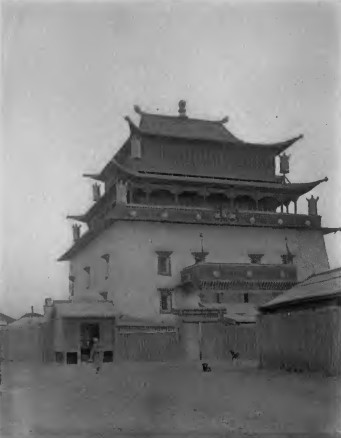 The Great Temple at Urga 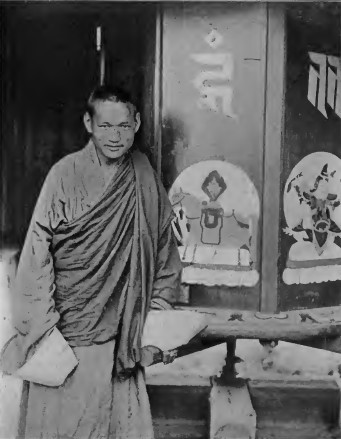 A Prayer Wheel and a Mongol Lama 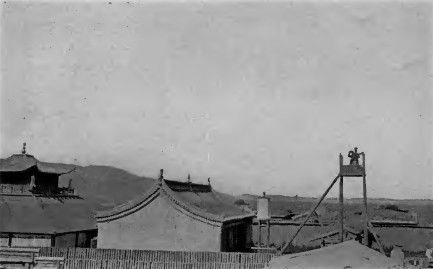 Lamas Calling the Gods at a Temple in Urga 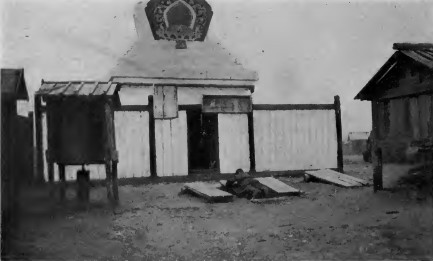 Mongol Praying at a Shrine in Urga The service ended abruptly in a roar of sound. Rising to their feet, the people streamed into the courtyard to whirl the prayer wheels about the temple's base. Each wheel is a hollow cylinder of varying size, standing on end, and embellished with Tibetan characters in gold. The wheels are sometimes filled with thousands of slips of paper upon which is written a prayer or a sacred thought, and each revolution adds to the store of merit in the future life. The Mongol goes farther still in accumulating virtue, and every native house in Urga is gay with fluttering bits of cloth or paper on which a prayer is written. Each time the little flag moves in the wind it sends forth a supplication for the welfare of the Mongol's spirit in the Buddhistic heaven. Not only are the prayer wheels found about the temples, but they line the streets, and no visiting Mongol need be deprived of trying the virtue of a new device without going to a place of worship. He can give a whirl or two to half a dozen within a hundred yards of where he buys his tea or sells his sheep. On every hand there is constant evidence that Urga is a sacred city. It never can be forgotten even for a moment. The golden roofs of scores of temples give back the sunlight, and the moaning chant of praying lamas is always in the air. Even in the main street I have seen the prostrate forms of ragged pilgrims who have journeyed far to this Mecca of the lama faith. If they are entering the city for the first time and crave exceeding virtue, they approach the great temple on the hill by lying face down at every step and beating their foreheads upon the ground. Wooden shrines of dazzling whiteness stand in quiet streets or cluster by themselves behind the temples. In front of each, raised slightly at one end, is a prayer board worn black and smooth by the prostrated bodies of worshiping Mongols. Although the natives take such care for the repose of the spirit in after life, they have a strong distaste for the body from which the spirit has fled and they consider it a most undesirable thing to have about the house. The stigma is imposed even upon the dying. In Urga a family of Mongols had erected their yurt in the courtyard of one of our friends. During the summer the young wife became very ill, and when her husband was convinced that she was about to die he moved the poor creature bodily out of the yurt. She could die if she wished, but it must not be inside his house. The corpse itself is considered unclean and the abode of evil spirits, and as such must be disposed of as quickly as possible. Sometimes the whole family will pack up their yurt and decamp at once, leaving the body where it lies. More usually the corpse is loaded upon a cart which is driven at high speed over a bit of rough ground. The body drops off at some time during the journey, but the driver does not dare look back until he is sure that the unwelcome burden is no longer with him; otherwise he might anger the spirit following the corpse and thereby cause himself and his family unending trouble. Unlike the Chinese, who treat their dead with the greatest respect and go to enormous expense in the burial, every Mongol knows that his coffin will be the stomachs of dogs, wolves, or birds. Indeed, the Chinese name for the raven is the "Mongol's coffin." The first day we camped in Urga, my wife and Mrs. MacCallie were walking beside the river. Only a short distance from our tent they discovered a dead Mongol who had just been dragged out of the city. A pack of dogs were in the midst of their feast and the sight was most unpleasant. The dogs of Mongolia are savage almost beyond belief. They are huge black fellows like the Tibetan mastiff, and their diet of dead human flesh seems to have given them a contempt for living men. Every Mongol family has one or more, and it is exceedingly dangerous for a man to approach a yurt or caravan unless he is on horseback or has a pistol ready. In Urga itself you will probably be attacked if you walk unarmed through the meat market at night. I have never visited Constantinople, but if the Turkish city can boast of more dogs than Urga, it must be an exceedingly disagreeable place in which to dwell. Although the dogs live to a large extent upon human remains, they are also fed by the lamas. Every day about four o'clock in the afternoon you can see a cart being driven through the main street, followed by scores of yelping dogs. On it are two or more dirty lamas with a great barrel from which they ladle out refuse for the dogs, for according to their religious beliefs they accumulate great merit for themselves if they prolong the life of anything, be it bird, beast, or insect. In the river valley, just below the Lama City, numbers of dogs can always be found, for the dead priests usually are thrown there to be devoured. Dozens of white skulls lie about in the grass, but it is a serious matter even to touch one. I very nearly got into trouble one day by targeting my rifle upon a skull which lay two or three hundred yards away from, our tent. The customs of the Mongols are not all as gruesome as those I have described, yet Urga is essentially a frontier city where life is seen in the raw. Its natives are a hard-living race, virile beyond compare. Children of the plains, they are accustomed to privation and fatigue. Their law is the law of the northland: ". . . . That only the Strong shall thrive, That surely the Weak shall perish and only the Fit survive." In the careless freedom of his magnificent horsemanship a Mongol seems as much an untamed creature of the plains as does the eagle itself which soars above his yurt. Independence breathes in every movement; even in his rough good humor and in the barbaric splendor of the native dress. But the little matter of cleanliness is of no importance in his scheme of life. When a meal has been eaten, the wooden bowl is licked clean with the tongue; it is seldom washed. Every man and woman usually carries through life the bodily dirt which has accumulated in childhood, unless it is removed by some accident or by the wear of years. One can be morally certain that it will never be washed off by design or water. Perhaps the native is not altogether to blame, for, except in the north, water is not abundant. It can be found on the plains and in the Gobi Desert only at wells and an occasional pond, and on the march it is too precious to be wasted in the useless process of bathing. Moreover, from September until May the bitter winds which sweep down from the Siberian steppes furnish an unpleasant temperature in which to take a bath. The Mongol's food consists almost entirely of mutton, cheese, and tea. Like all northern people, he needs an abundance of fat, and sheep supply his wants. There is always more or less grease distributed about his clothes and person, and when Mongols are en masse the odor of mutton and unwashed humanity is well-nigh overpowering. I must admit that in morality the Mongol is but little better off than in personal cleanliness. A man may have only one lawful wife, but may keep as many concubines as his means allow, all of whom live with the members of the family in the single room of the yurt. Adultery is openly practiced, apparently without prejudice to either party, and polyandry is not unusual in the more remote parts of the country. The Mongol is unmoral rather than immoral. He lives like an untaught child of nature and the sense of modesty or decency, as we conceive it, does not enter into his scheme of life. But the operation of natural laws, which in the lower animals are successful in maintaining the species, is fatally impaired by the loose family relations which tend to spread disease. Unless Lamaism is abolished I can see little hope for the rejuvenation of the race. In writing of Urga's inhabitants and their way of life I am neglecting the city itself. I have already told of the great temple on the hill and its clustering lama houses which overlook and dominate the river valley. Its ornate roof, flashing in the sun, can be seen for many miles, like a religious beacon guiding the steps of wandering pilgrims to the Mecca of their faith. At the near end of the broad street below the Lama City is the tent market, and just beyond it are the blacksmith shops where bridles, cooking pots, tent pegs, and all the equipment essential to a wandering life on the desert can be purchased in an hour — if you have the price! Nothing is cheap in Urga, with the exception of horses, and when we began to outfit for our trip on the plains we received a shock similar to that which I had a month ago in New York, when' paid twenty dollars for a pair of shoes. We ought to be hardened to it now, but when we were being robbed in Urga by profiteering Chinese, who sell flour at ten and twelve dollars a sack and condensed milk at seventy-five cents a tin, we roared and grumbled — and paid the price! I vowed I would never pay twenty dollars for a pair of shoes at home, but roaring and grumbling is no more effective in procuring shoes in New York than it was in obtaining flour and milk in Urga. We paid in Russian rubles, then worth three cents each. (In former years a ruble equaled more than half a dollar.) Eggs were well-nigh nonexistent, except those which had made their way up from China over the long caravan trail and were guaranteed to be "addled" — or whatever it is that sometimes makes an egg an unpleasant companion at the breakfast table. Even those cost three rubles each! Only a few Russians own chickens in Urga and their productions are well-nigh "golden eggs," for grain is very scarce and it takes an astounding number of rubles to buy a bushel. Fortunately we had sent most of our supplies and equipment to Urga by caravan during the winter, but there were a good many odds and ends needed to fill our last requirements, and we came to know the ins and outs of the sacred city intimately before we were ready to leave for the plains. The Chinese shops were our real help, for in Urga, as everywhere else in the Orient, the Chinese are the most successful merchants. Some firms have accumulated considerable wealth and the Chinaman does not hesitate to exact the last cent of profit when trading with the Mongols. At the eastern end of Urga's central street, which is made picturesque by gayly painted prayer wheels and alive with a moving throng of brilliant horsemen, are the Custom House and the Ministry of Foreign Affairs. The former is at the far end of an enormous compound filled with camel caravans or loaded carts. There is a more or less useless wooden building, but the business is conducted in a large yurt, hard against the compound wall. It was an extraordinary contrast to see a modern filing-cabinet at one end and a telephone box on the felt-covered framework of the yurt. Not far beyond the Custom House is what I believe to be one of the most horrible prisons in the world. Inside a double palisade of unpeeled timbers is a space about ten feet square upon which open the doors of small rooms, almost dark. In these dungeons are piled wooden boxes, four feet long by two and one-half feet high. These coffins are the prisoners' cells. Some of the poor wretches have heavy chains about their necks and both hands manacled together. They can neither sit erect nor lie at full length. Their food, when the jailer remembers to give them any, is pushed through a six-inch hole in the coffin's side. Some are imprisoned here for only a few days or weeks; others for life, or for many years. Sometimes they lose the use of their limbs, which shrink and shrivel away. The agony of their cramped position is beyond the power of words to describe. Even in winter, when the temperature drops, as it sometimes does, to sixty degrees below zero, they are given only a single sheepskin for covering. How it is possible to live in indescribable filth, half-fed, well-nigh frozen in winter, and suffering the tortures of the damned, is beyond my ken — only a Mongol could live at all. The prison is not a Mongol invention. It was built by the Manchus and is an eloquent tribute to a knowledge of the fine arts of cruelty that has never been surpassed. I have given this description of the prison not to feed morbid curiosity, but to show that Urga, even if it has a Custom House, a Ministry of Foreign Affairs, motor cars, and telephones, is still at heart a city of the Middle Ages. In Urga we made a delightful and most valuable friend in the person of Mr. F. A. Larsen. Most foreigners speak of him as "Larsen of Mongolia" and indeed it is difficult for us to think of the country without thinking of the man. Some thirty years ago he rode into Mongolia and liked it. He liked it so much, in fact, that he dug a well and built a house among the Tabool hills a hundred miles north of Kalgan. At first he labored with his wife as a missionary, but later he left that field to her and took up the work which he loved best in all the world — the buying and selling of horses. During his years of residence in Mongolia hundreds of thousands of horses have passed under his appraising eyes and the Mongols respect his judgment as they respect the man. I wish that I might write the story of his life, for it is more interesting than any novel of romance or adventure. In almost every recent event of importance to the Mongols Mr. Larsen's name has figured. Time after time he has been sent as an emissary of the Living Buddha to Peking when misunderstandings or disturbances threatened the political peace of Mongolia. Not only does he understand the psychology of the natives, but he knows every hill and plain of their vast plateau as well as do the desert nomads. For some time he had been in charge of Andersen, Meyer's branch at Urga with Mr. E. W. Olufsen and we made their house our headquarters. Mr. Larsen immediately undertook to obtain an outfit for our work upon the plains. He purchased two riding ponies for us from Prince Tze Tze; he borrowed two carts with harness from a Russian friend, and bought another; he loaned us a riding pony for our Mongol, a cart horse of his own, and Mr. Olufsen contributed another. He made our equipment a personal matter and he was never too busy to assist us in the smallest details. Moreover, we could spend hours listening to the tales of his early life, for his keen sense of humor made him a delightful story-teller. One of the most charming aspects of our wandering life is the friends we have made in far corners of the world, and for none have we a more affectionate regard than for "Larsen of Mongolia." 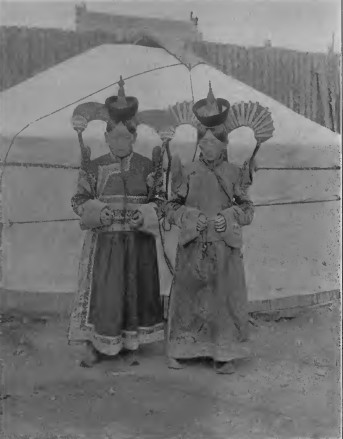 Mongol Women Beside a Yurt 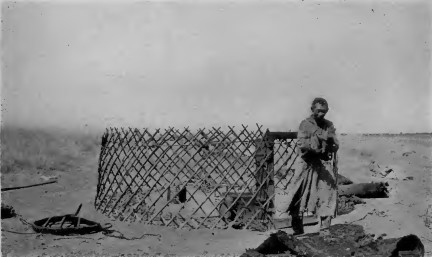 The Framework of a Yurt 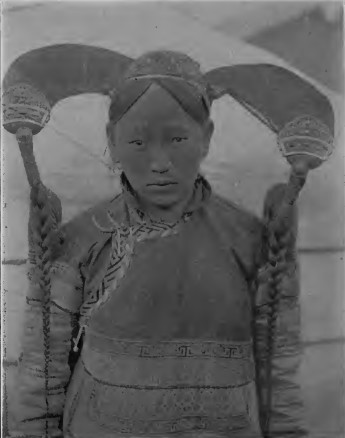 The Headdress of a Mongol Married Woman 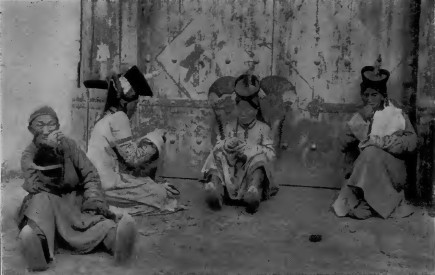 Mongol Women and a Lama |